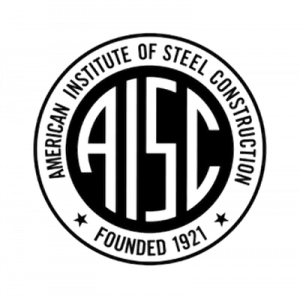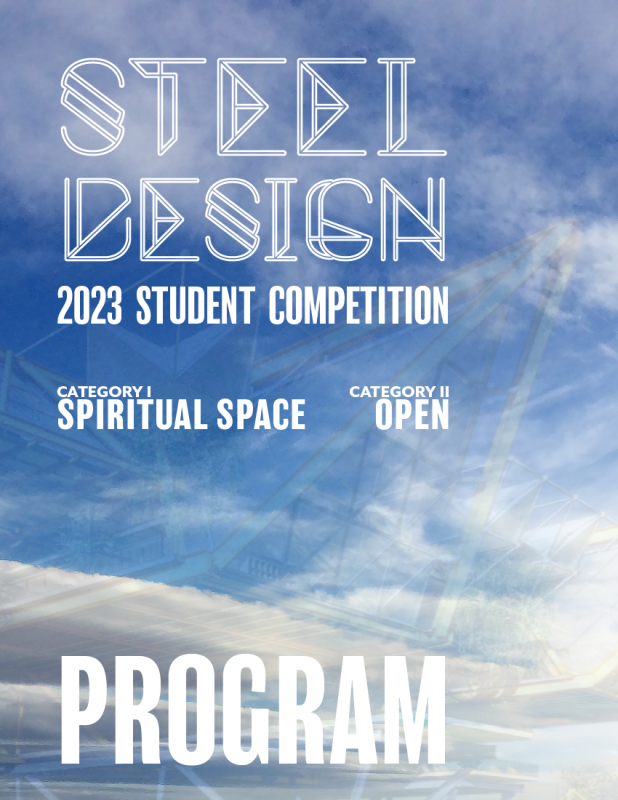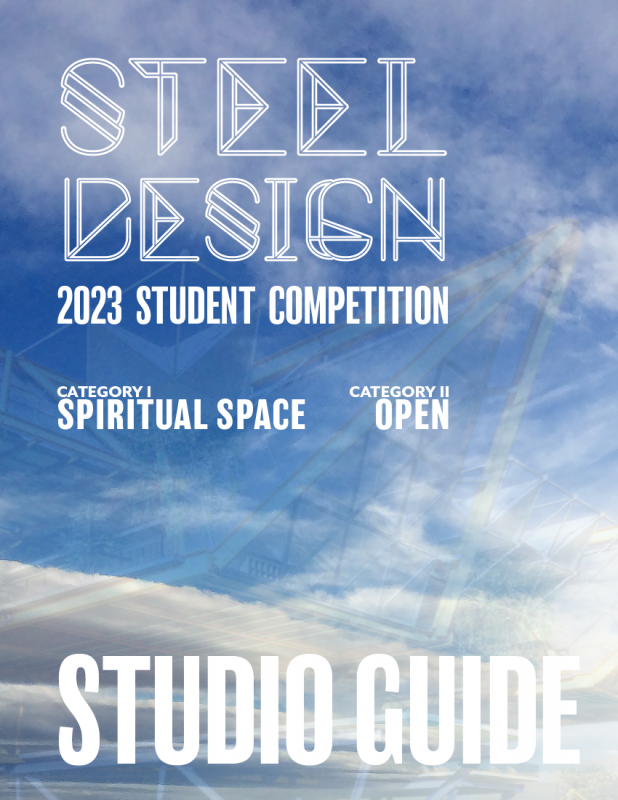Resources
A goal of all ACSA competitions is to make students aware that research is a fundamental element of any design solution. Students are encouraged to research material properties and methods of steel construction, as well as precedent projects that demonstrate innovative use of structural steel.
Steel Video Resources
- Architecturally Exposed Structural Steel (Steel Video Resources) – VIDEO
- What is AESS (Steel Video Resources) – VIDEO
- Steel Coatings & Protection (Steel Video Resources) – VIDEO
- Steel Connections (Steel Video Resources) – VIDEO
- Custom Steel (Steel Video Resources) – VIDEO
- Tension: Force Differentiated Structural Steel Design (Steel Video Resources) – VIDEO
- Span: Exploiting the Tensile Strength of Steel (Steel Video Resources) – VIDEO
- What is AESS (AISC) – VIDEO
- Steel Coatings & Protection (AISC) – VIDEO
- Steel Connections (AISC) – RESOURCES
Steel Construction References
- AISC website: aisc.org
- Modern Steel Construction: This authoritative monthly magazine is made available online free of charge. This magazine covers the use of fabricated structural steel in the variety of structural types. It presents information on the newest and most advanced applications of structural steel in a wide range of structures. Issues of Modern Steel Construction (1996 – Present) are available online. Visit modernsteel.com to view them.
- Steel Connections – RESOURCES
- Terri Meyer Boake. Understanding Steel Design: An Architectural Design Manual. (Birkhäuser 2013)
- John Fernandez. Material Architecture. (Spon Press, 2006)
- Victoria Bell and Patrick Rand. Materials for Design 2. (Princeton Architectural Press, 2014)
- Shulitz, Habermann, Sobek. Steel Construction Manual. (Birkhäuser Basel 2000)
- Annette LeCuyer. Steel and Beyond. (Birkhäuser Basel 2003)
- Sutherland Lyall. Remarkable Structure: Engineering today’s Innovative Buildings. (Princeton Architectural Press, 2002)
Further Reading about Spiritual Architecture
- Thomas Barrie. The Sacred In-Between. (Routledge, 2010)
- Julio Bermudez, editor. Transcending Architecture: Contemporary Views on Sacred Space. (The Catholic University of America Press, 2015)
- Karla Britton, editor. Constructing the Ineffable: Contemporary Sacred Architecture. (Yale University Press, 2020)
- Michael J. Crosbie. “Contemporary Trends in Sacred Architecture,” in Theology in Built Environments, Sigurd Bergmann, Editor; New Brunswick, NJ. (Transaction Publishers, 2009, pp. 59-67)
- Michael J. Crosbie and Julio Bermudez. “Searching for New Sacred Space.” (Faith & Form, Vol. 49, No. 2, 2016, pp. 6-11)
- Michael J. Crosbie. “A Sanctuary for Interdependence.” (Faith & Form, Vol. 50, No. 1, 2017, pp. 30-31)
- Michel J. Crosbie, “Campus Sacred Spaces Are Changing,” (ArchDaily) https://www.archdaily.com/989449/campus-sacred-spaces-are-changing?ad_source=search&ad_medium=projects_tab&ad_source=search&ad_medium=search_result_all
- Victor Kazanjian and Stephen Kieran. “Design From Dialogue.” (Faith & Form, Vol. 42, No. 3, 2009, pp. 6-11)
- Michael J. Crosbie. “Architecture for the Spirit,” in Architecture: Celebrating the Past, Designing the Future, Edited by Nancy Solomon, Washington, D.C.: The American Institute of Architects, 2008, pp. 314-334.
- Mircea Eliade. The Sacred and the Profane. (Harcourt, Brace & World, 1959)
- Howard Hebel. “Numen Lumen: Pushing the Multifaith Model Forward.” (Faith & Form, Vol. 47, No. 2, 2014, pp. 14-18)
- Pallister, James, Sacred Spaces: Contemporary Religious Architecture. (Phaidon Press, 2015)
- Pew Research Center. “When Americans say they believe in God, what do they mean?” (https://www.pewresearch.org/religion/2018/04/25/when-americans-say-they-believe-in-god-what-do-they-mean/ , 2018
- Sheri Wing, Designing Sacred Spaces 1st Edition. (Routlege, 2015)
Competition Sponsor

The American Institute of Steel Construction (AISC), headquartered in Chicago, is a non-partisan, not-for-profit technical institute and trade association established in 1921 to serve the structural steel design community and construction industry in the United States. AISC’s mission is to make structural steel the material of choice by being the leader in structural-steel-related technical and market-building activities, including: specification and code development, research, education, technical assistance, quality certification, standardization, market development, and advocacy. AISC has a long tradition of service to the steel construction industry providing timely and reliable information.
Membership to AISC is free to university faculty and full-time students, and AISC membership provides valuable benefits. Information can be found at www.aisc.org/universityprograms.
Competition Organizer

Association of Collegiate Schools of Architecture (ACSA)
Leading Architectural Education and Research
ACSA is a nonprofit, membership association founded in 1912 to advance the quality of architectural education. The school membership in ACSA has grown from 10 charter members to over 250 schools in several membership categories. These include full membership for all accredited programs in the United States and government-sanctioned schools in Canada, candidate membership for schools seeking accreditation, and affiliate membership for schools for two-year and international programs. Through these schools, over 5,000 architecture faculty members are represented. In addition, over 500 supporting members composed of architecture firms, product associations and individuals add to the breadth of interest and support of ACSA goals. ACSA provides a major forum for ideas on the leading edge of architectural thought. Issues that will affect the architectural profession in the future are being examined today in ACSA member schools.
Program Author
Michael J. Crosbie has made significant contributions in architectural criticism, research, education, and practice during his nearly forty-year career. He won ACSA’s Distinguished Professor in 2022 and is the sole author or editor of, or contributor to, more than 75 books on architecture, including over 7 books and chapters on spiritual architecture. Crosbie has served as an editor at Architecture: The AIA Journal and Progressive Architecture and was editor-in-chief of Faith & Form: The Interfaith Journal on Religion, Art, and Architecture. He has published hundreds of articles on architectural design, practice, and education, and is a regular contributor to ArchDaily and Common Edge. His work has been recognized with several awards for his writing, including the Edward S. Frey Memorial Award in Recognition of the Contributions Made to Religion, Art, and Architecture, bestowed by the American Institute of Architects. In 2012 he was elected to the AIA’s College of Fellows. Crosbie is Professor of Architecture at the University of Hartford, as well as the former Chair of the Department of Architecture, Graduate Program Director, and Associate Dean of the College of Engineering, Technology, and Architecture.
Image Credit (background):
2021 Steel Competition: 1st Place, Cat. I: Workplace Wellness
Project Title: Immersive Workplace
Students: Moises Lio Can, Zaw Latt, Yaning Zhang, & Ming Xu
Faculty Sponsor: Clark E. Llewellyn, FAIA
Institution: University of Hawai’i at Mānoa
Questions
Edwin Hernández
Programs Coordinator
ehernandez@acsa-arch.org
202.785.2324
Eric W. Ellis
Senior Director of Operations and Programs
202-785-2324
eellis@acsa-arch.org

 Study Architecture
Study Architecture  ProPEL
ProPEL 

